Read Reviews
The Best Reciprocating Saws
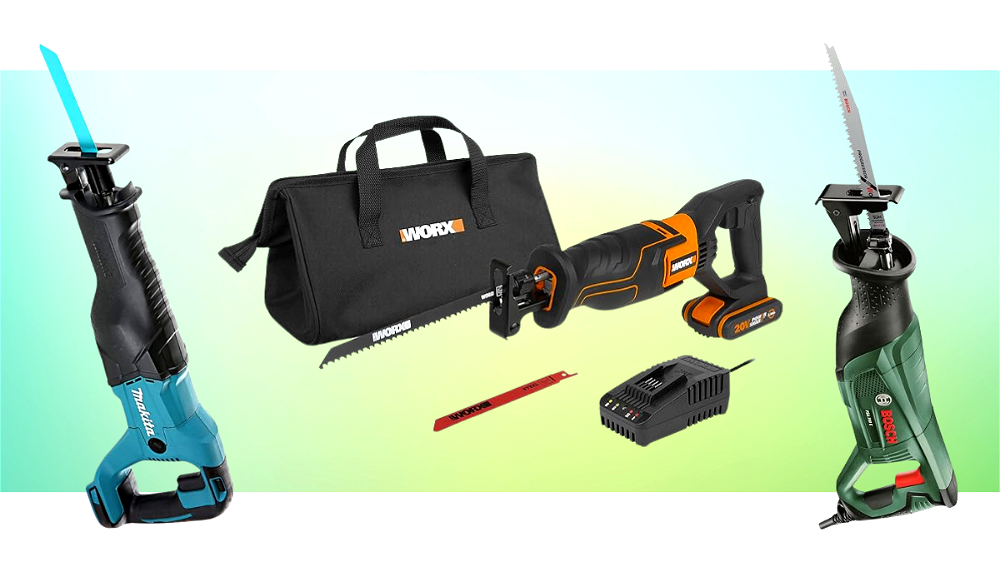
-
Best corded all rounder - Bosch PSA 700E 710 Watt Corded Sabre Saw
-
Best reciprocating saw with toolbag - WORX WX500.9 18V Cordless Reciprocating Saw
-
Best cordless reciprocating saw for stroke length - Makita DJR186Z LXT 18V Reciprocating Saw
-
Best corded reciprocating saw for cutting depth - Bosch Professional GSA 1100 E 1,100 Watt Reciprocating Saw
-
Best budget corded reciprocating saw - WORKPRO 710W Corded Reciprocating Saw
-
Best lightweight cordless reciprocating saw - Einhell TE-AP 18 Li-Solo Cordless All Purpose Saw
-
Best lightweight corded reciprocating saw - VonHaus 800 Watt Reciprocating Sabre Saw
Reciprocating Saw Reviews
1. Bosch PSA 700E 710 Watt Corded Sabre Saw[ SAVE 34% ]
Best corded all rounder
- The included Bosch S2345X progressor is an excellent wood saw blade. It’s aggressive enough for dealing with hard woods, and long enough to give you plenty of useful life.
- I prefer Bosch’s method for securing the saw blades. Instead of a twisting collar, they provide a small handle that can be operated with just one finger. It makes tool less blade changes even easier!
- This is a remarkably good value saw to own. Compared with the expense of the Makita DJR186Z, you get a capable saw that doesn’t need extra batteries or chargers.
- The maximum cutting depth of 150 mm in wood is impressive. Compared with the VonHaus sabre saw, you can tackle 45 mm more per cut.
- There’s an obvious disadvantage to even the best corded reciprocating saw. Working up a ladder or at the bottom of the garden becomes a challenge in finding a long-enough extension cord.
- Weighing in at 3 kg, this isn’t a lightweight piece of kit. Unless you’re particularly strong and confident, one-handed use is out of the question.
- There’s no way to adjust the length of the sole plate. This is disappointing as you’re forced to use the same section of blade teeth for every cut. An adjustable plate is more economical.
- Compared with the HYCHIKA reciprocating saw, this tool doesn’t come with a safety switch. It might make it easier to use, but without a safety it can accidentally turn on.
- Type
- Corded
- Power
- Mains - 710W
- Battery & charger
- n/a
- Strokes per minute
- 0-2,700spm
- Stroke length
- 20mm
- Cutting depth
- 150mm
- Blades included
- 1
- Weight
- 3.0kg
- Build Quality
- 4
- Performance
- 4
- Value for Money
- 4
Needing little introduction, German tool giants Bosch make two distinct levels of kit. You can get the blue Professional range or the green DIY range, depending on your budget and what you need the tool to do. This PSA 700E corded sabre saw falls into the green DIYer category, but it doesn’t mean it’s a toy. This is a solid and capable piece of equipment.
Starting with what Bosch do really well, the rear handle is supremely comfortable. Like a lot of Bosch tools there’s a rubberised lip at the top of the grip section. This small addition really helps to keep your rear hand in the optimum cutting position. The front grip section features acres of rubber and another lip to help you apply the correct amount of pressure to each cut.
The 710 Watt motor drives the blade up to 2,700 spm. Although the stroke length is only 20 mm, it can tackle decent sizes of timber and even mild steel pipe. You get a fair amount of cord to play with too, 2.5 m is enough for some jobs without resorting to an extension cable.
Did you find this review helpful?
2. WORX WX500.9 18V Cordless Reciprocating Saw
Best reciprocating saw with toolbag
- You don’t need to own a set of batteries or a charger to get working straight away. Compared with the Makita DJR186Z, this is a better choice for beginner DIYers because they’re both included.
- The 3,000 spm blade speed is really impressive. It’s got the fastest cutting action on my list and should help to saw through a range of materials quickly.
- The tool less blade change mechanism is easy to use and robust. It feels like it’ll last for a long time and means you can use the saw blades in either direction as well.
- The maximum cutting depth of 130 mm is quite impressive. It won’t beat the Makita but compared with the Einhell TE-AP it’s got more capacity for cutting timber.
- The stroke length on this saw is a tiny 20 mm. This means you’re stuck with cutting materials with the same few blade teeth unless you adjust the footplate often. It’s not an efficient use of the saw blades.
- The soft case that comes with this saw is a bit pointless. It’s OK for carrying the saw around, but it’s not going to protect it from knocks or drops and it’s far too big to start with!
- WORX have included a rather small 2.0 Ah battery with this saw. It’s a power hungry machine, and a small battery like this won’t last long during use. Upgrade it soon.
- The 20 Volt MAX battery isn’t any more powerful compared to the Einhell TE-AP or the Makita LXT 18 Volt ones. All 18 Volt batteries can produce 20 Volts maximum.
- Type
- Cordless
- Power
- Battery - 18V
- Battery & charger
- 2.0Ah battery+charger
- Strokes per minute
- 0-3,000spm
- Stroke length
- 20mm
- Cutting depth
- 130mm
- Blades included
- 1
- Weight
- 2.1kg
- Build Quality
- 4
- Performance
- 5
- Value for Money
- 5
Boasting a decent range of power tools and even robotic lawn mowers, WORX are no strangers to quality tools for decent prices. The WX500.9 cordless reciprocating saw is light, easy to handle, and comes with a battery, charger, and soft carry case.
Starting off with the design, you get a large rear handle that can accommodate large hands even when they’re in gloves. The trigger’s a bit on the small side but you can still control the blade speed quite easily. The front of the saw is encased in a rubber boot, which helps to keep down vibrations and makes it comfortable to hold too.
There’s a handy adjustable footplate on this reciprocating saw too. You can use the onboard lever to change the length of the blade that sticks out of the end of the tool. This could help extend the life of your blade and give you more control over how you cut materials like metal, plastic, or wood.
Weighing in at a mere 2.1 kg, this is a lightweight bit of kit that should be usable for any DIYer and is even light enough for one-handed use if you’re feeling confident. It might not be the heaviest duty demolition saw out there, but it’s more than enough for most jobs around the home and garden.
Did you find this review helpful?
3. Makita DJR186Z LXT 18V Reciprocating Saw [ SAVE 43% ]
Best cordless reciprocating saw for stroke length
- The enormous rubberised “boot” on the front of the saw makes this saw easy to hang on to as well as protecting it against even the worst knocks and drops. It’s a tank!
- Cutting the cord makes this a versatile and safe saw to use. Pairing this saw up with Makita’s excellent LXT batteries means you can keep the extension cord in the shed where it belongs.
- The unbeatable stroke length for each cut means this saw can cut to a maximum depth of 255 mm. That means you can deal with pretty huge bits of timber easily.
- The motor puts out an impressive 2,800 strokes per minute (spm), so when combined with the long stroke length it has unbeatable cutting power.
- You’re not just limited to working on timber with this saw. Changing saw blades is as simple as it gets, and with a metal cutting blade you can deal with unwanted bolts as well!
- Be prepared for this saw to chew through your batteries. Even with high capacity 5.0 Ah batteries on board, you can’t run the saw for long. It’s a hungry beast, so make sure you have spares.
- In comparison with the Einhell TE-AP 18 Li, this is a heavy bit of kit. It’s almost twice the weight, which makes it much harder to use for long periods.
- Don’t be mistaken, this reciprocating saw is sold as a “naked” tool. That means you’ll need to get yourself some batteries and a charger as well. It’s not ideal for the absolute novice DIYer.
- For some jobs, this heavy duty reciprocating saw is ideal. However it’s nowhere near as manoeuvrable as other cordless reciprocating saws.
- Some users have complained that the saw is too long and too heavy for one handed use. It can be a bit limiting if you need to hold the saw with both hands all the time.
- Type
- Cordless
- Power
- Battery - 18V
- Battery & charger
- None
- Strokes per minute
- 0-2,800spm
- Stroke length
- 32mm
- Cutting depth
- 255mm
- Blades included
- 0
- Weight
- 3.8kg
- Build Quality
- 5
- Performance
- 5
- Value for Money
- 4
Japan’s premier tool brand Makita doesn’t need much of an introduction. DIYers and professionals around the world know that they make some of the best reciprocating saws available right now. The DJR186Z 18V cordless reciprocating saw is big, powerful, and provides unbeatable cutting power.
One of the best uses for a reciprocating saw is for demolition, so it’s a good thing that this beast is built like a tank. It’s not going to win any awards for being lightweight at 3.5 kg without a battery, but it’s incredibly good at what it’s designed for. And that’s making rough cuts in tight spaces that other cordless reciprocating saws can’t reach. It’s rugged, hard-wearing, and has an excellent stroke length of 32 mm.
Designed to be comfortable to use even with big work gloves on, I was pleased to see a large grip and substantial two-finger trigger. It makes variable speed control easy, especially if you’ve got big hands like I have. The rest of the rubberised grip is comfortable too. It also feels well balanced, even with a large 5.0 Ah battery on board.
This is the best reciprocating saw for professional tradespeople on my list. The tool less blade change makes it simple enough for any DIYer to get the hang of though. You can’t really go wrong with this cordless reciprocating saw, it’s capable and comfortable to use. I love it!
Did you find this review helpful?
4. Bosch Professional GSA 1100 E 1,100 Watt Reciprocating Saw
Best corded reciprocating saw for cutting depth
- Bosch have included a seriously handy metal rafter hook on the top of this saw. It means you’ve got somewhere to hang it between cutting jobs. I love it!
- They’ve included a seriously powerful LED work light into the front of the tool. It means you can work in dingy corners and underneath worktops without any extra illumination.
- Boasting a heavy duty thick rubber power cable, you get a massive 4 m to play with. That’s plenty of length even if you’re up a ladder. A vital addition to corded reciprocating saws like this.
- It’s good to see a safety switch on this sabre saw. In comparison with the Bosch PSA 700E, you’re a lot less likely to accidentally switch it on.
- The downside of having that powerful 1,100 Watt motor on board is all the extra weight. Weighing in at a mighty 3.6 kg, you’ll need to be strong to use this at arm’s length.
- Several users have complained about the lack of comfort in the rear handle. For a professional level tool, the grip is basic in shape and doesn’t have enough rubber on it.
- This professional level reciprocating saw isn’t supplied with any saw blades at all. Compared to the Bosch PSA 700E, it’s disappointing that it’s not supplied with one of their S2345X progressor saw blades.
- Adjusting the sole plate length is a bit of a pain. You need to undo a pair of bolts on the underside of the tool. It’s not as easy compared with the easy change on the Einhell TE-AP.
- Type
- Corded
- Power
- Mains - 1,100W
- Battery & charger
- n/a
- Strokes per minute
- 0-2,700spm
- Stroke length
- 28mm
- Cutting depth
- 230mm
- Blades included
- 0
- Weight
- 3.6kg
- Build Quality
- 5
- Performance
- 5
- Value for Money
- 4
Moving up a level in capability and power, the Bosch Professional GSA 1100 E makes up part of their blue line of tools. This is a step up from the Bosch PSA 700E thanks to some clever features and unbeatable build quality.
Supplied with a chunky but basic rear grip and large two-finger trigger, there’s space for big hands in thick gloves. The front section is covered in rubber and well-shaped to provide an excellent amount of grip and vibration control.
Featuring the same quick blade release mechanism as the Bosch PSA 700E, you can easily switch between wood and metal cutting saw blades. The big 1,100 Watt motor puts out 2,700 spm and had a stroke length of 28 mm. This gives this saw an impressive 230 mm maximum cut depth in wood, and you can even tackle up to 20 mm thick metal plate! This must be one of the best demolition saws currently on the UK market. It’s big, but it’s also incredibly powerful.
Did you find this review helpful?
5. WORKPRO 710W Corded Reciprocating Saw
Best budget corded reciprocating saw
- Compared with the Bosch GSA 1100 E, changing the length of the sole plate bracket was much easier. The single hex key supplied with the kit makes for an easy adjustment.
- It’s hard to fault a reciprocating saw like this for the price. It’s not the heaviest duty saw on my list, and it can’t cut huge pieces of material, but you get an awful lot for the money.
- The button on the rear handle isn’t a safety switch but a lock on switch. This means you can keep the power on without hanging onto the trigger.
- The spm rate of 2,800 puts this sabre saw up there with the more expensive tools on my list. The faster you can work the saw, the more versatile the tool is.
- If you’re planning on cutting through metal plate, this might not be the best reciprocating saw for you. Rated to a maximum of 4 mm, it’s only good for rather thin sheets.
- The power cable isn’t made from nice, rubberised plastic. It’s a bit plasticky, and only reaches 1.8 m in length. It’s pretty stingy and won’t reach up a ladder.
- It’s great that WORKPRO have included four saw blades, but they’re on the small side. Compared with the excellent Bosch S2345X progressor blades, they’re nowhere near as good.
- This saw isn’t quite as powerful compared with the VonHaus reciprocating saw. The 710 Watt motor is going to struggle and heat up more quickly unless you take frequent breaks.
- Type
- Corded
- Power
- Mains - 710W
- Battery & charger
- n/a
- Strokes per minute
- 0-2,800spm
- Stroke length
- 20mm
- Cutting depth
- 115mm
- Blades included
- 4
- Weight
- 2.5kg
- Build Quality
- 4
- Performance
- 4
- Value for Money
- 5
Producing all types of clever kit from cordless drills to leaf blowers, WORKPRO have found the balance between budget-friendly and reliable DIY kit. The Workpro 710 Watt corded reciprocating saw is a good example of that. It won’t break the bank but still produces a decent level of output.
The rear handle setup is quite basic, it might not have as much rubber grip compared with the WORK WX500, but for the price, it’s not terrible. There’s plenty of rubber on the front of the saw to keep vibrations down and give you something to hang on to though. The 710 Watt motor puts out a notable 2,800 spm, which should make up for the rather ordinary 20 mm stroke length.
It’s handy that WORKPRO have included four blades to get you started. It’s an ideal place to start for DIYers who don’t want to overspend on a single job. It might not be as capable as the big saws on my list, but it only weighs 2.5 kg. It’ll cut through a maximum depth of 115 mm in wood at a push.
Did you find this review helpful?
6. Einhell TE-AP 18 Li-Solo Cordless All Purpose Saw[ SAVE 5% ]
Best lightweight cordless reciprocating saw
- You get a 2.5 Ah battery included with this saw. It’s a more powerful one compared with the WORX WX500, so you’ll get more working time per charge.
- At just 165 mm long, you can get this saw into tighter spots than most cordless reciprocating saws. Sometimes it’s millimetres that count when you need to get the job done.
- Adjusting the sole plate is a piece of cake! Simply press the big red lock symbol on the front right of the saw, and you can tweak the distance for different tasks.
- Even though this isn’t the heaviest duty saw on my list, it can still tackle metal plate up to 6 mm thick. That’s not bad for a lightweight battery operated reciprocating saw.
- Some users have complained that the saw overheats easily and becomes too hot to touch! If you understand the limitations of this saw you can avoid this, it’s not a heavy duty tool.
- Even though the battery included with this saw is more powerful compared to other cordless models, it’s still not big enough to run for a long time. Make sure you’ve got spares!
- Several users have complained about excessive vibration from this tool. You need to make sure you’re using the right technique to avoid shaking too much.
- The maximum cut depth is only 100 mm in timber. That’s the smallest of all the saws on my list. It might be manoeuvrable and compact, but it comes at a price.
- Type
- Cordless
- Power
- Battery - 18V
- Battery & charger
- 2.5Ah battery+charger
- Strokes per minute
- 0-2,600spm
- Stroke length
- 22mm
- Cutting depth
- 100mm
- Blades included
- 1
- Weight
- 1.6kg
- Build Quality
- 4
- Performance
- 4
- Value for Money
- 5
German tool brand Einhell have made their mark on the cordless power tool scene with their Power X-Change 18 Volt battery system. The lightest and smallest reciprocating saw on my list, the Einhell TE-AP 18 Li-Solo is wonderfully easy to handle and can get into tight spots that the competition can’t reach.
Decked out in Einhell’s recognisable red, this reciprocating saw features a comfortable rear handle that helps to keep some of the vibrations down. The front of the saw doesn’t have quite as much rubber compared with the WORX WX500, but it’s still a rugged-looking bit of kit.
Einhell’s patented Triathlon motor powers up this saw to 2,600 spm. Combined with the reasonable 22 mm stroke length it’s capable enough for a cordless saw at this price. And you don’t need to fork out for any extras as they’ve included a reasonable size 2.5 Ah battery and charger too.
Did you find this review helpful?
7. VonHaus 800 Watt Reciprocating Sabre Saw
Best lightweight corded reciprocating saw
- VonHaus have somehow managed to produce a useful sabre saw for a really low price. If you’re budget conscious and don’t want to overspend, this is the best reciprocating saw for you.
- They’ve thrown in a pair of saw blades to get you started. One for wood and one for metal, they’re ideal for getting started and learning how the tool operates.
- Weighing just 2.4 kg, this is a seriously lightweight sabre saw! The low weight means it’s easy to handle and you can use it for long periods without getting too tired.
- The included hex key makes adjusting the shoe plate an easy job. Like the WORKPRO, you can change the plate length with a single screw.
- Several users have warned that the lock on button is too easy to engage. I’m not a fan of these types of buttons as they can pose a safety risk unless you’re paying full attention.
- The power cable is woefully short at just over 1 m. It’s a money saving exercise by VonHaus but means that you’ll be reaching for the extension cord all the time. A bit disappointing.
- The 105 mm maximum cut depth in wood is the least impressive for all the corded saws on my list. Even with that more powerful 800 Watt motor!
- It’s a shame that this saw doesn’t feature a safety switch. It’s an essential bit of it for anyone that isn’t confident or experienced in using power tools, in my opinion.
- Type
- Corded
- Power
- Mains - 800W
- Battery & charger
- n/a
- Strokes per minute
- 0-2,800spm
- Stroke length
- 20mm
- Cutting depth
- 105mm
- Blades included
- 2
- Weight
- 2.4kg
- Build Quality
- 4
- Performance
- 4
- Value for Money
- 5
VonHaus’s recognisable orange tools have been finding themselves in the workshops and sheds of DIYers all over the place in recent years. The Manchester-based homewares brand make capable but wallet-friendly kit for everything in and around the house.
Packing a slightly bigger motor than other budget reciprocating saws on my list, there are 800 Watts to play with under the hood with this VonHaus reciprocating saw. This produces 2,800 spm and allows the 20 mm stroke length to cut a maximum depth of 105 mm in wood.
The rear handle might be a bit basic, but there’s a big enough rubber boot on the front to make it comfortable to hang on to. You can also adjust the cutting speed with the little wheel embedded in the trigger. Like the WORKPRO, you can adjust the shoe plate angle and length to get the most out of the two supplied blades.
Did you find this review helpful?
Compare Product Features
Use the dropdown to sort the table by the feature you want to see.
Bosch PSA 700E 710 Watt Corded Sabre Saw
- 4
- Corded
- Mains - 710W
- n/a
- 0-2,700spm
- 20mm
- 150mm
- 1
- 3.0kg
WORX WX500.9 18V Cordless Reciprocating Saw
- 4.7
- Cordless
- Battery - 18V
- 2.0Ah battery+charger
- 0-3,000spm
- 20mm
- 130mm
- 1
- 2.1kg
Makita DJR186Z LXT 18V Reciprocating Saw
- 4.7
- Cordless
- Battery - 18V
- None
- 0-2,800spm
- 32mm
- 255mm
- 0
- 3.8kg
Bosch Professional GSA 1100 E 1,100 Watt Reciprocating Saw
- 4.7
- Corded
- Mains - 1,100W
- n/a
- 0-2,700spm
- 28mm
- 230mm
- 0
- 3.6kg
WORKPRO 710W Corded Reciprocating Saw
- 4.3
- Corded
- Mains - 710W
- n/a
- 0-2,800spm
- 20mm
- 115mm
- 4
- 2.5kg
Einhell TE-AP 18 Li-Solo Cordless All Purpose Saw
- 4.3
- Cordless
- Battery - 18V
- 2.5Ah battery+charger
- 0-2,600spm
- 22mm
- 100mm
- 1
- 1.6kg
VonHaus 800 Watt Reciprocating Sabre Saw
- 4.3
- Corded
- Mains - 800W
- n/a
- 0-2,800spm
- 20mm
- 105mm
- 2
- 2.4kg
How to Choose The Best Reciprocating Saw
Reciprocating saws (also known as recip saws or saber saws) are brilliant tools for quickly cutting through a range of coarser materials. They can easily cut through materials such as metal, coarse timber, plasterboard, and plastic and so make ideal power tools to have handy on a building site or large DIY project.
The powerful push and pull (reciprocation) action of these saws is the key to cutting quickly and efficiently through tough materials. The reciprocating saw does not necessarily provide the neatest of cuts, so if finish matters more consider a circular saw. However, for conveniently cutting through materials where the finish is not a priority, such as plasterboard or plastic pipes, reciprocating saws are the ideal no-fuss electric cutting saw.
Furthermore, these power tools are designed for heavy-duty cutting and this makes them great for demolition work such as cutting up old fences, decking, or removing stud partitioning.
Reciprocating saws can also be very useful around the garden for tasks such as pruning or cutting up branches for the stove or bonfire. They are also handy for cutting up rubbish such as pallets or old furniture for easy removal from the house.
Cordless reciprocating saws add even more convenience as there is no need to run power cables to the worksite or garden. With such a variety of uses, reciprocating saws make a very handy power tool that takes the hard work out of practically any household cutting job.
The best reciprocating saw will come with variable speed control and toolless blade changing but it is worth double-checking these features as these may not be present on some budget models. Variable speed is particularly important if you are cutting a range of different materials as some, such as wood, are best cut at a faster cutting speed and others, such as metal, at slower speeds.
The battery used with cordless reciprocating saws is an important consideration. Look for those powered by lithium-ion batteries and choose a battery rated at least 2 Ah. If you already have power tools with batteries and chargers then you can buy a body-only (bare) tool to save money.
Reciprocating Saw FAQs
The saw blade you choose will depend on the material you wish to cut. You can buy wood, metal, and bi-metal blades for your reciprocating saw and these will cover most uses. There are also dedicated saw blades available for tree trimming and other specialist uses. You can also buy heavy-duty saw blades with diamond or carbide chips. While these are more expensive than bi-metal blades they will last longer and work out more cost-effective if you use your saw a lot.
Basically, if you are cutting clean wood, choose a wood blade and for metal, choose a metal saw blade. However, for multi-purpose uses, or wood that may contain nails, choose a carbide or bi-metal blade.
It is worth choosing saw blades from a quality manufacturer. Quality saw blades make for faster and easier jobs and the blades will last longer too.
A reciprocating saw is a power tool often picked up in a hurry when we need to quickly cut something to size or rip out something we no longer want. Furthermore, we often use reciprocating saws in awkward positions such as in tight spaces or overhead. So before you power on the saw, remember to follow some basic safety precautions.
Ensure you are working in a clean work environment and remove obstacles and tripping hazards. Check the area you are going to cut, especially if it is a concealed surface that may hide pipework or electric cables. Steady yourself in a stable position before beginning work. Make sure you have enough light to see clearly what you are doing.
Always wear safety goggles, work gloves, solid footwear, ear defenders, and a mask when using your reciprocating saw, and it goes without saying to keep your hands away from the saw blade.
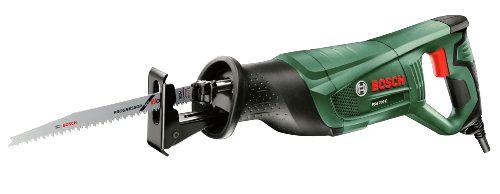
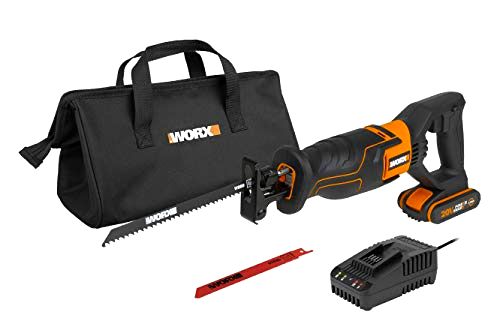
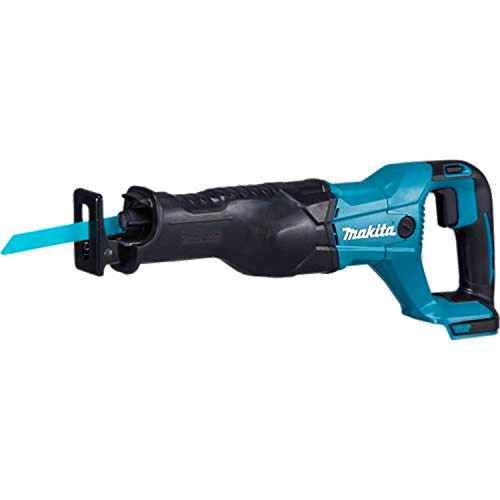
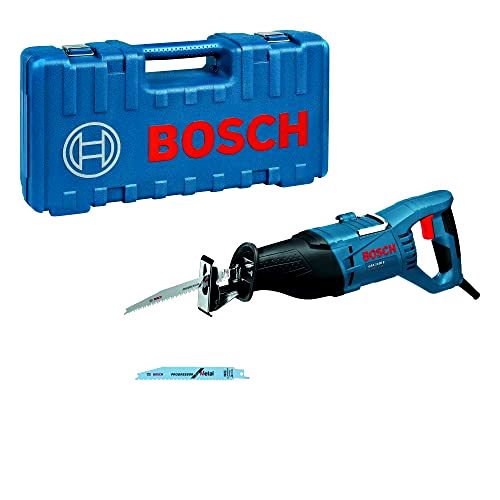
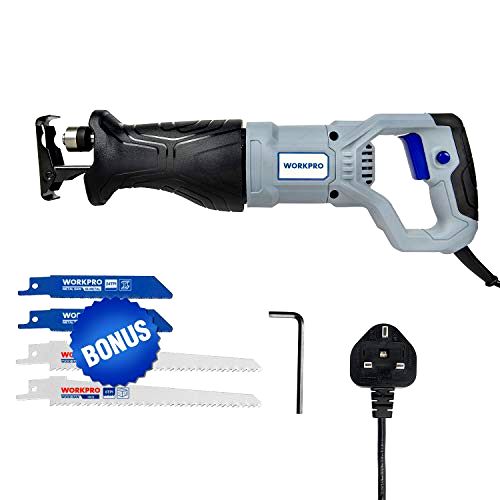
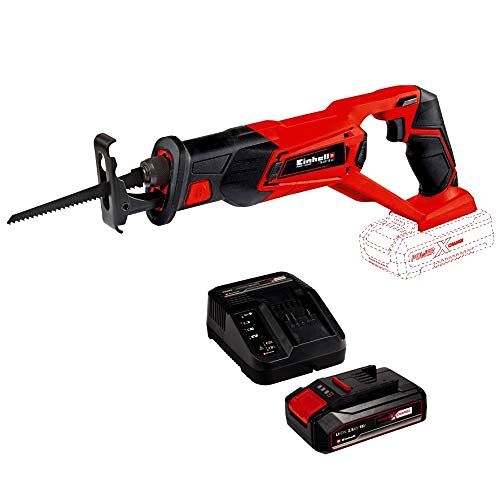
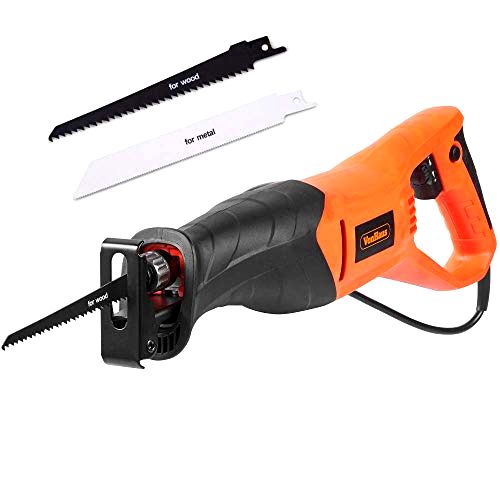

Share